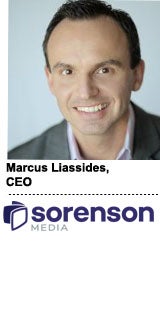Although cable operators used to be the primary keepers of TV’s distribution and data pipes, the pendulum is swinging toward programmers and smart-TV providers.
Addressable inventory is increasing, driven by a surge in smart-TV OEMs licensing their data directly and local TV companies adding data and automation to their sales mixes.
Sorenson Media, which is backed by Sinclair Broadcasting and Hearst, wants to capitalize on that opportunity by putting more power back in the hands of programmers.
Sorenson allows local broadcast partners to dynamically insert targeted ads at the household level, while also helping television manufacturers like Samsung serve targeted ads or harness more viewing data from smart TVs.
Sorenson’s next step is democratizing access to data and inventory across smart-TV providers and programmers.
AdExchanger spoke with Marcus Liassides, CEO of Sorenson Media, about addressable’s impact on local and smart TV.
AdExchanger: As more viewership moves from standard cable subscriptions to streaming and video on demand, how does that impact content owners?
MARCUS LIASSIDES: As someone moves from pay TV to Netflix, they’re essentially removing lots of ad impressions from the space. It’s not just about cutting the cord.
On the one hand, content owners are scared. But on the other hand, it makes ad inventory much more finite and affords [programmers] an opportunity to drive up prices if you have the right capability with data.
The current Nielsen model is still based on a panel that’s extrapolated out, but we’re moving toward a world where audience data can be much more actionable.
Eighty billion dollars in the US is still being spent on Nielsen ratings by modeling out from a relatively small panel. We felt there was a way to improve that environment.
Will virtual MVPDs like Sling TV and DirecTV Now increase the availability of addressable TV data?
The vMVPDs have always had a lot of data, and part of the frustration from the ad and [TV] station community is that data has been closed up with the operator. There was an ability to access some of that data if you bought ad campaigns through Comcast, for instance, but if you’re a station or an advertiser, you weren’t getting much data back from MVPDs as a whole.
One reason we’ve been able to gain traction is because people haven’t looked at the operators with a great deal of like because they’ve been such entrenched gatekeepers of data and protected a lot of value for themselves. I’m not picking a fight with Comcast, but the way the TV ecosystem is structured has afforded us a lot of opportunity.
Is this one of the reasons why we’re seeing a rise in programmer consortiums, such as Univision/Nexstar/Sinclair?
A lot of the reason comes down to the regulatory environment. Broadcast stations still have a lot of regulatory overhead in the things they can do together, which hasn’t really existed in the digital world. One of the largest sellers of local ad space is NCC Media, which is a consortium between Time Warner, Charter and Comcast.
The operators have that opportunity to collaborate and create a much more streamlined buying experience for the ad industry. Broadcasters haven’t traditionally had that. They’ve been prohibited from creating what’s called interconnects, and there’s quite some pressure in DC to relieve that regulatory overhead because they feel like they’re becoming less competitive if an advertiser has to go to each individual station group to make a buy when they can go directly to NCC, and it’s much easier.
A lot of the regulation is considered quite antiquated, since it was put in place to protect operators when they were forming and they were the small underdogs. Now that they’re huge businesses, a lot of people feel the need for that regulation has changed quite significantly.
Where do you see the most opportunity in local addressability?
We’re focused on the $20 billion spent on local TV media. Sinclair is focused on the $150 billion spent on local media more holistically. Of that $150 billion, only 14% is being spent on local broadcast. About 28% of that is being spent on local direct mail. Addressability will bring that targeting capability, which direct mail has down to the household [level], to television.
Before you even get to advertising, programmers and content owners need to understand their audience at an individual level, not at a modeled-out level. Initially we focused on taking analytics and data products to market with a number of large station groups and large networks. What we’re focused on now is partnering and working with TV manufacturers and stations to help them move into other revenue opportunities.
What do you mean?
We’re focused on the roll-out of an addressable TV platform, which will open up a vast amount of inventory that isn’t currently addressable. We’ve built it down all the way to self-serve, and an advertiser can come in and buy addressable TV impressions for the audience they’re looking for in the same way as they would Google’s AdWords or Facebook inventory.
Local inventory is one example, but there will also be national network inventory. Even though there’s addressable advertising running on their network stations, it’s being inserted by the operator for the two minutes an hour they’re allotted. It doesn’t allow the remaining 16 minutes in the hour to be addressable at all, so our capabilities will aim to open that up.
Interview condensed.














